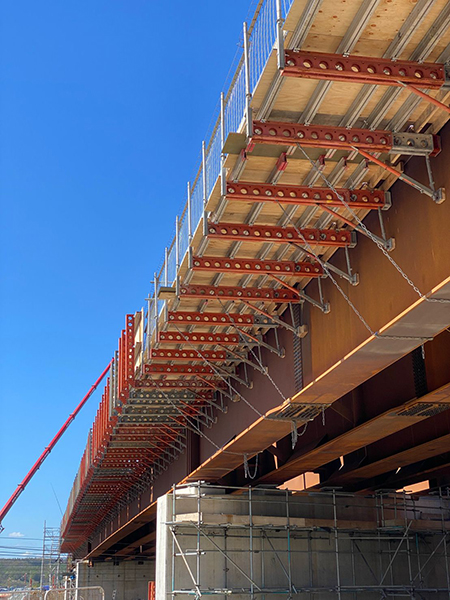
Charlie McKillop, northern regional engineering manager at Altrad RMD Kwikform, discusses why agility and transparency are essential for temporary works suppliers, and the importance of certifications and engineering expertise.
CONTRACTORS are under more pressure than ever before to deliver projects to ever tightening timescales, so speed of construction has become essential. What’s more, we are seeing architecture that is much more adventurous, adding to the complexity of construction.
The location of a project can often have an impact on what temporary works are suitable, with access to inner city environments or areas close to water posing additional challenges. Temporary works suppliers will see a wide range of projects too – from road bridges and railway viaducts, to high rise apartments, airport towers, and stadiums.

With formwork accounting for significant costs on building projects, due consideration should be given to selecting proper temporary works solutions to curb the costs of inefficiencies and help boost productivity on site.
Labour productivity is a major opportunity to improve efficiency – whether freeing up workers for other tasks or speeding up activities. The use of formwork systems that require less labour for assembly and dismantling can aid in increasing productivity.
System formwork is much faster to erect and can often be used in a modular format, saving a significant amount of time, as modules can be simply moved from one section of the project, to the next. By training the onsite teams to erect these systems safely and swiftly, contractors can achieve very fast cycle times.

Agile working
Agility is another key factor, and being able to adapt to different requirements is essential. Formwork equipment may not have evolved dramatically in recent years, but the way in which we are using it to fulfil increasingly complex requirements has required ingenuity.
Drawings have become increasingly advanced, and we now utilise digital technologies such as CAD, BIM and VR to help us visualise formwork specifications, and analyse available data to prove a solution can work.
These digital tools can also help streamline processes, delivering improved collaboration and greater efficiencies. For instance, one of the key benefits of using digital engineering tools is that they can help all stakeholders view, interrogate, communicate information, and raise questions about a project.

In the temporary works sector, digital technology allows high-quality and realistic 3D visualisations of a proposed system on a project. This helps resolve any communication barriers that might have previously been an issue, achieving a new-found transparency across the entire project. Digital tools help ensure there are fewer risks associated with projects, as issues can be quickly raised and remedied by contractors before the build has even started. One example is clash detection, and hard clashes – such as a concrete column running through a wall – can have a huge impact upon the costs and time frame of a build, especially if they are only spotted once on-site.
Working on one collaborative, coordinated building model means that contactors can save time and money avoiding on clashes, and make the entire process more efficient for everyone involved.
Knowledge sharing
There has been a historical trend of temporary works suppliers keeping knowledge and data to themselves as leverage against competitors. However, it has become apparent in recent years that a more transparent approach can benefit everyone in the industry. We’ve been involved in initiatives such as CONSTRUCT and the Temporary Works Forum, encouraging open discussion of any matter related to temporary works.
By sharing information, we develop better processes and solutions, resulting in a more effective offering for our customers.

Accreditations also go a long way to offer peace of mind, and meeting the latest regulatory requirements provides our customers with the confidence when specifying and using our equipment. For example, we are accredited by Achilles, certified to BSI ISO 9001 and ISO 14001, plus, our ground shoring equipment is fully CE UKCA marked to BS EN1090 execution Class 3 standard.
Involving suppliers at the earliest stage possible of a project for collaboration and insight is beneficial. Ultimately, it’s the engineering expertise of the temporary works provider that is crucial, to be able to understand the requirements of a project, specify the best equipment for the job, and keep an agile mindset when it comes to problem solving and overcoming challenges.









